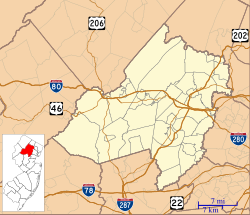Fosterfields | |
 Joseph W. Revere House | |
| Location | Junction of Mendham and Kahdena Roads, Morris Township, New Jersey |
|---|---|
| Coordinates | 40°48′6″N 74°30′16″W / 40.80167°N 74.50444°W |
| Area | 213.4 acres (86.4 ha)[2] |
| Built | 1854 |
| Architect | Joseph Warren Revere |
| Architectural style | Gothic Revival style |
| Part of | Washington Valley Historic District (ID92001583) |
| NRHP reference No. | 73001127[1] (original) 91000478[3] (increase) |
| NJRHP No. | 2175; 2176[4] |
| Significant dates | |
| Added to NRHP | September 20, 1973 |
| Boundary increase | October 9, 1991 |
| Designated CP | November 12, 1992 |
| Designated NJRHP | January 29, 1973 March 11, 1991 |
Fosterfields, also known as Fosterfields Living Historical Farm, is a 213.4-acre (86.4 ha) farm and open-air museum at the junction of Mendham and Kahdena Roads in Morris Township, New Jersey. The oldest structure on the farm, the Ogden House, was built in 1774.[5] Listed as the Joseph W. Revere House, Fosterfields was added to the National Register of Historic Places on September 20, 1973, for its significance in art, architecture, literature, and military history.[6] The museum portrays farm life circa 1920.[7][8]
United States Navy officer, adventurer and author Joseph Warren Revere, a grandson of Paul Revere, was a significant owner of the property.[9] During Revere's ownership he designed and built an 1854 Carpenter-Gothic mansion titled "The Willows."[5][10][11]
In 1881 Charles Grant Foster, a New York commodities broker, purchased the property and developed it into a Jersey cattle farm entitled "Fosterfields." His daughter, Caroline Rose Foster, spent 98 years living and working on the property, enjoying carpentry, fishing, and civic engagement during the Gilded Age of Morristown.[9]
While writing her will in 1974, Caroline Foster arranged to bequeath the land to the Morris County Park Commission following her death, with the intent of making the property an educational farm.[12][13][14][15][8] Upon Foster's death in 1979, the Park Commission received the farm.[16][17] The boundary was increased on October 9, 1991.[18] It was listed as a contributing property of the Washington Valley Historic District on November 12, 1992.[19]
- ^ "National Register Information System – (#73001127)". National Register of Historic Places. National Park Service. November 2, 2013.
- ^ "Fosterfields Living Historical Farm". Morris County Park Commission. Archived from the original on January 21, 2021. Retrieved January 16, 2021.
- ^ "National Register Information System – (#91000478)". National Register of Historic Places. National Park Service. November 2, 2013.
- ^ "New Jersey and National Registers of Historic Places – Morris County" (PDF). New Jersey Department of Environmental Protection – Historic Preservation Office. December 28, 2020. p. 14. Archived (PDF) from the original on May 16, 2013. Retrieved February 3, 2021.
- ^ a b Cite error: The named reference
:02was invoked but never defined (see the help page). - ^ Gamble, Robert S.; Kerschner, Terry (July 19, 1972). "National Register of Historic Places Inventory/Nomination: Joseph W. Revere House". National Park Service. With accompanying 2 photos
- ^ Press, Independent (August 26, 2012). "Tour The Willows in Morristown". nj. Archived from the original on March 25, 2022. Retrieved May 16, 2022.
- ^ a b "Fosterfields Living Historical Farm | Morris County Parks". www.morrisparks.net. Archived from the original on January 21, 2021. Retrieved May 16, 2022.
- ^ a b Barbara, Hoskins; Foster, Caroline; Roberts, Dorothea; Foster, Gladys (1960). Washington Valley, an informal history. Edward Brothers. OCLC 28817174.
- ^ Cite error: The named reference
:1was invoked but never defined (see the help page). - ^ Cite error: The named reference
:5was invoked but never defined (see the help page). - ^ Barbato, Joan (May 5, 1989). "Restoration of "Willows" completed, B1". Daily Record. Morristown, New Jersey. pp. B1. Archived from the original on April 15, 2022. Retrieved April 15, 2022.
- ^ Barbato, Joan (May 5, 1989). "Restoration of "Willows" complete, B4". Daily Record. Morristown, New Jersey. pp. B4. Archived from the original on April 15, 2022. Retrieved April 15, 2022.
- ^ Friends of Fosterfields: The Farm Archived July 23, 2011, at the Wayback Machine
- ^ Press, Independent (August 26, 2012). "Tour The Willows in Morristown". nj. Archived from the original on March 25, 2022. Retrieved March 24, 2022.
- ^ Nadzeika, Bonnie-Lynn (2012). Morristown. Arcadia Publishing. ISBN 978-0-7385-9280-0. Archived from the original on May 20, 2022. Retrieved May 18, 2022.
- ^ "Fosterfields". www.usgenwebsites.org. Archived from the original on May 20, 2022. Retrieved May 16, 2022.
- ^ Strathearn, Nancy (August 16, 1990). "National Register of Historic Places Inventory/Nomination: Fosterfields (Boundary Increase)". National Park Service. With accompanying 28 photos
- ^ Foster, Janet W. (November 12, 1992). "NRHP Nomination: Washington Valley Historic District". National Park Service.
- "NRHP Nomination: Washington Valley Historic District (56 photos)". National Park Service. 1991.


